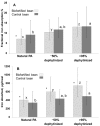Review: The potential of the common bean (Phaseolus vulgaris) as a vehicle for iron biofortification
- PMID: 25679229
- PMCID: PMC4344581
- DOI: 10.3390/nu7021144
Review: The potential of the common bean (Phaseolus vulgaris) as a vehicle for iron biofortification
Abstract
Common beans are a staple food and the major source of iron for populations in Eastern Africa and Latin America. Bean iron concentration is high and can be further increased by biofortification. A major constraint to bean iron biofortification is low iron absorption, attributed to inhibitory compounds such as phytic acid (PA) and polyphenol(s) (PP). We have evaluated the usefulness of the common bean as a vehicle for iron biofortification. High iron concentrations and wide genetic variability have enabled plant breeders to develop high iron bean varieties (up to 10 mg/100 g). PA concentrations in beans are high and tend to increase with iron biofortification. Short-term human isotope studies indicate that iron absorption from beans is low, PA is the major inhibitor, and bean PP play a minor role. Multiple composite meal studies indicate that decreasing the PA level in the biofortified varieties substantially increases iron absorption. Fractional iron absorption from composite meals was 4%-7% in iron deficient women; thus the consumption of 100 g biofortified beans/day would provide about 30%-50% of their daily iron requirement. Beans are a good vehicle for iron biofortification, and regular high consumption would be expected to help combat iron deficiency (ID).
Figures




References
-
- Debouck D.G., Toro O., Paredes O.M., Johnson W.C., Gepts P. Genetic diversity and ecological distribution of Phaseolus vulgaris (Fabaceae) in northwestern South America. Econ. Bot. 1993;47:408–423. doi: 10.1007/BF02907356. - DOI
-
- HarvestPlus Iron-bean, 2009. [(accessed on 26 January 2015)]. Available online: http://www.harvestplus.org/sites/default/files/HarvstPlus_Bean_Strategy.pdf.
-
- Broughton W.J., Hernandez G., Blair M., Beebe S., Gepts P., Vanderleyden J. Beans (Phaseolus spp.)-model food legumes. Plant Soil. 2003;252:55–128.
Publication types
MeSH terms
Substances
LinkOut - more resources
Full Text Sources
Other Literature Sources
Miscellaneous

